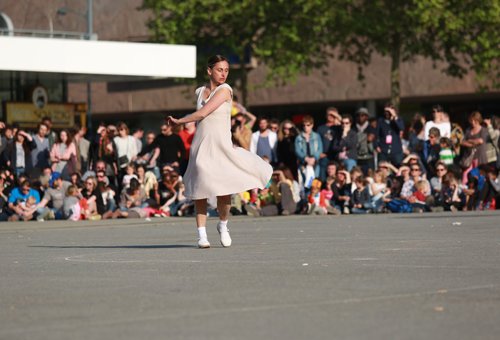
If you find yourself in a city square, empty as a blank page, without bleachers, props, or a tent, only with bodies, ready to dance? To fill the public space with signs, movements, memories, energy?
Launched by the Musée de la danse, Fous de danse is an invitation to experience dance in all its forms, across a range of practices.
From noon to midnight, the Esplanade Charles-de-Gaulle will transform into an ephemeral theatre for the dancing community: a warm-up for everyone, participatory choreographies, a giant Soul Train, shows, urban dance clubs, fest-deiz, and a dance floor will follow one another at a maddening pace.
Of course, there will be music and this will be a feast for the eyes and feet. There will be plenty to feel and imitate, to contemplate and explore. There will be hundreds of us, running, lining up, drifting, prancing, circle dancing, like pigments, atoms, brushwork, dancers of the stars.
Gilles Amalvi
Fous de danse [Mad about dance] is the title of a journal published in the 1980s which won over a whole generation of future dancers and choreographers. The idea of a collective mania—a craze for a movement that takes hold of people body and soul—was behind the conception of this extraordinary event which aims at generating a continuum of gestures, forms, and intensities in the public space. As it is being constantly curtailed, regulated, and controlled, what can be done in the “public” space? How to transform it from within, to foster a shared dimension? Perhaps dance is one of the ways to invent togetherness: a restless, overflowing togetherness that sweeps across age groups, social classes, and genders, that engages “amateurs” and “professionals” alike. This is the desire driving Fous de danse: to create an ephemeral dancing community; to fill the mineral surface of the Esplanade Charles-de-Gaulle with bodies and various states; to invent a choreographic form that transforms over time; and to invite the public to take part in this metamorphosis of the space and the gestures populating it.
The Musée de la danse is not, in my mind, limited to a location, collections, works, or shows. While it is a center, where dance confronts works, words, and images, it is also a periphery, an expansion of its own perimeter. It derives its meaning from this openness onto the outside, from the direct contact with what bodies can invent and transmit at all levels of society. In keeping with this extension of the domain of dance, Fous de danse reflects the desire to throw our doors wide open to the promotion of a living, moving exhibition accessible to all; a dance that takes flight, breaks free, and spreads, that takes us from a warm-up to the presentation of solos by the Opera dancers, from the heat of the dance floor to the energy of the giant Soul Train where everyone can take part in the cortège and improvise their own funky moves. Everything is “in place”: workshops, Fest Deiz, urban dances, Anne Teresa De Keersmaeker… Everything is there with no dividing lines, no towering stage, no décor. It might rain, it might be windy: the clouds and the sun will join the party. Choreographic, meteorological, sociological, ecstatic, democratic? Fous de danse will be energetic or not at all.
Boris Charmatz
Running time: 10h
Professionals dancers and visitors
Production: Musée de la danse / Centre chorégraphique national de Rennes et de Bretagne – Direction: Boris Charmatz. Association supported by the French Ministry of Culture and Communication (Direction Régionale des Affaires Culturelles / Bretagne), the city of Rennes, the regional Council of Brittany and the General Council of Ille-et-Vilaine.
The Institut français contributes regularly to the international touring of the Musée de la danse.
Premiered in 2015 at Esplanade Charles de Gaulle, Rennes, France.
Cover picture: © Yann Peucat, Musée de la danse 2016 / Violin Phase (extrait de Fase) de et avec Anne Teresa De Keersmaeker, Fous de danse, Rennes, 2016



